Ever wondered which tactical style is the best for the EFL Championship? We’ve seen an array of tactics and approaches throughout the EFL this season, and England’s second tier is a good advert for tactical variety. We have possession-dominant sides such as Southampton, aggressive pressing sides like Preston North End, and direct teams such as Stoke City.
This data analysis aims to uncover the varied tactical styles within the Championship and which sides are the most successful within their tactical constraints compared to other sides who play a similar way. We’ll begin by providing an overview of statistics such as goal scoring/conceding rates, etc. – these will be useful reference points for the article as a whole. The analysis will then dive deeper into specific data to highlight what the numbers tell us about the tactics of each team – are they a high-pressing team? Do they like to cross the ball often? We will also aim to see if there is any tactical trend or pattern in relation to success/league position – i.e. are possession-based teams generally doing better than direct teams?
Overview
We start with a series of graphs that gives us an outline of the general output of each side – basic data that informs us on their performance this season. The graphs in this segment of analysis will also provide you with a reference point for certain discussion points throughout the data analysis.
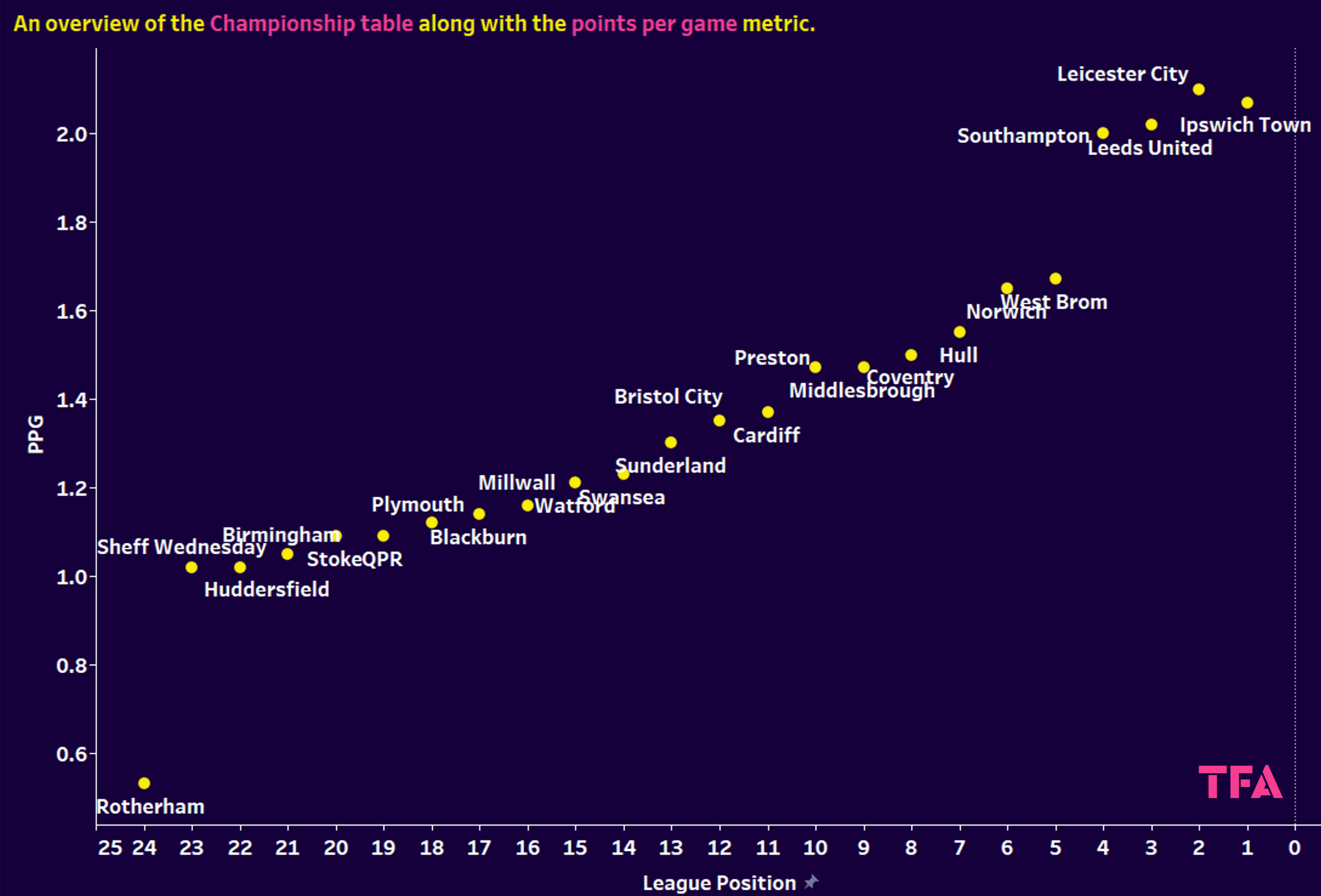
To begin, we have an overview of the league standings, looking at each team’s points per game record. As mentioned, this will serve as something to come back to when discussing certain data points later.
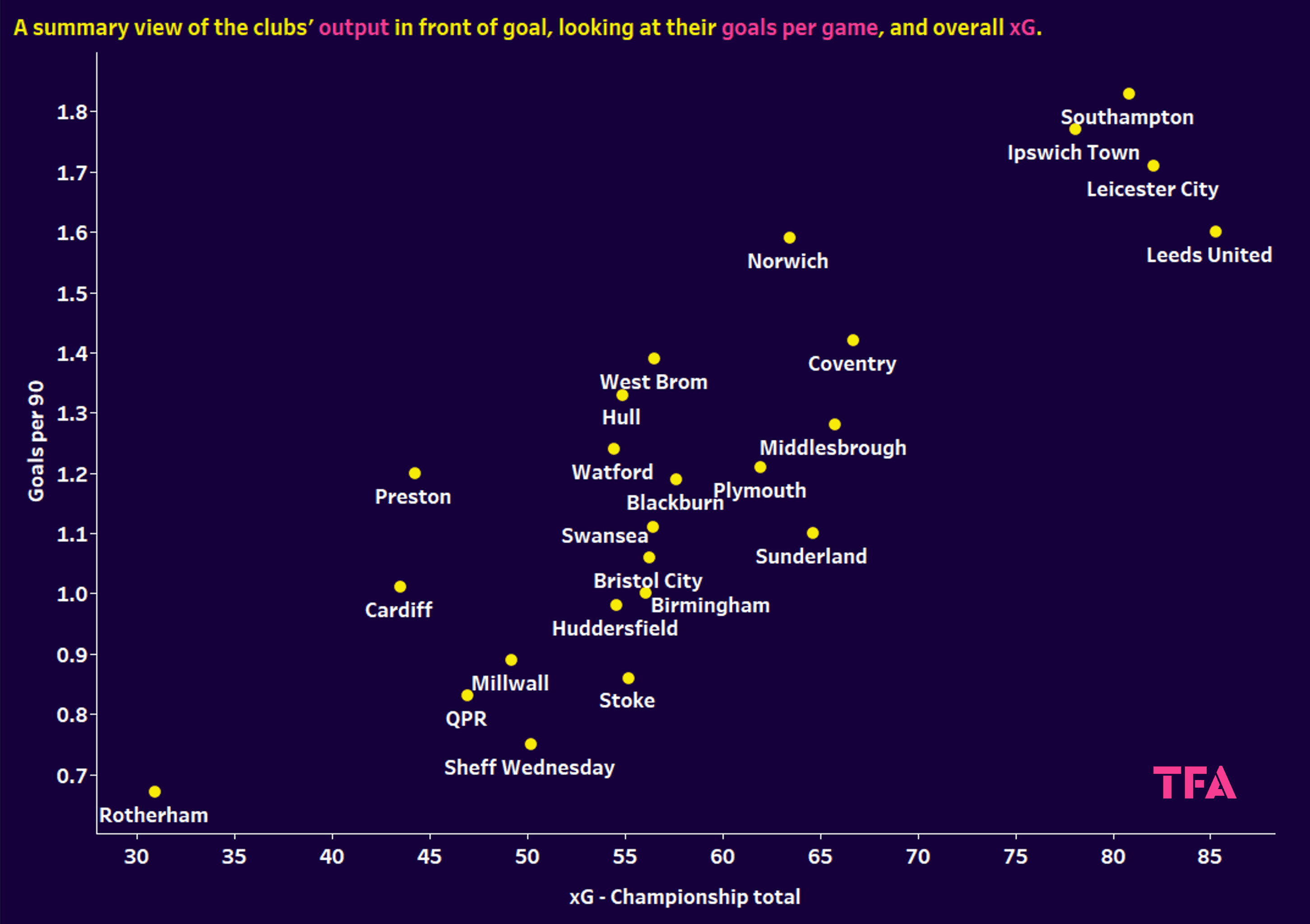
Moving onto their goalscoring abilities, as you may suspect – the teams near the top of the table are creating better-quality chances and scoring more goals. Leeds United have the highest xG in the Championship at the time of writing (85.26) but have been outscored on a game-to-game basis by Leicester City, Ipswich Town, and Southampton – all teams who are hoping to secure a spot in next season’s Premier League.
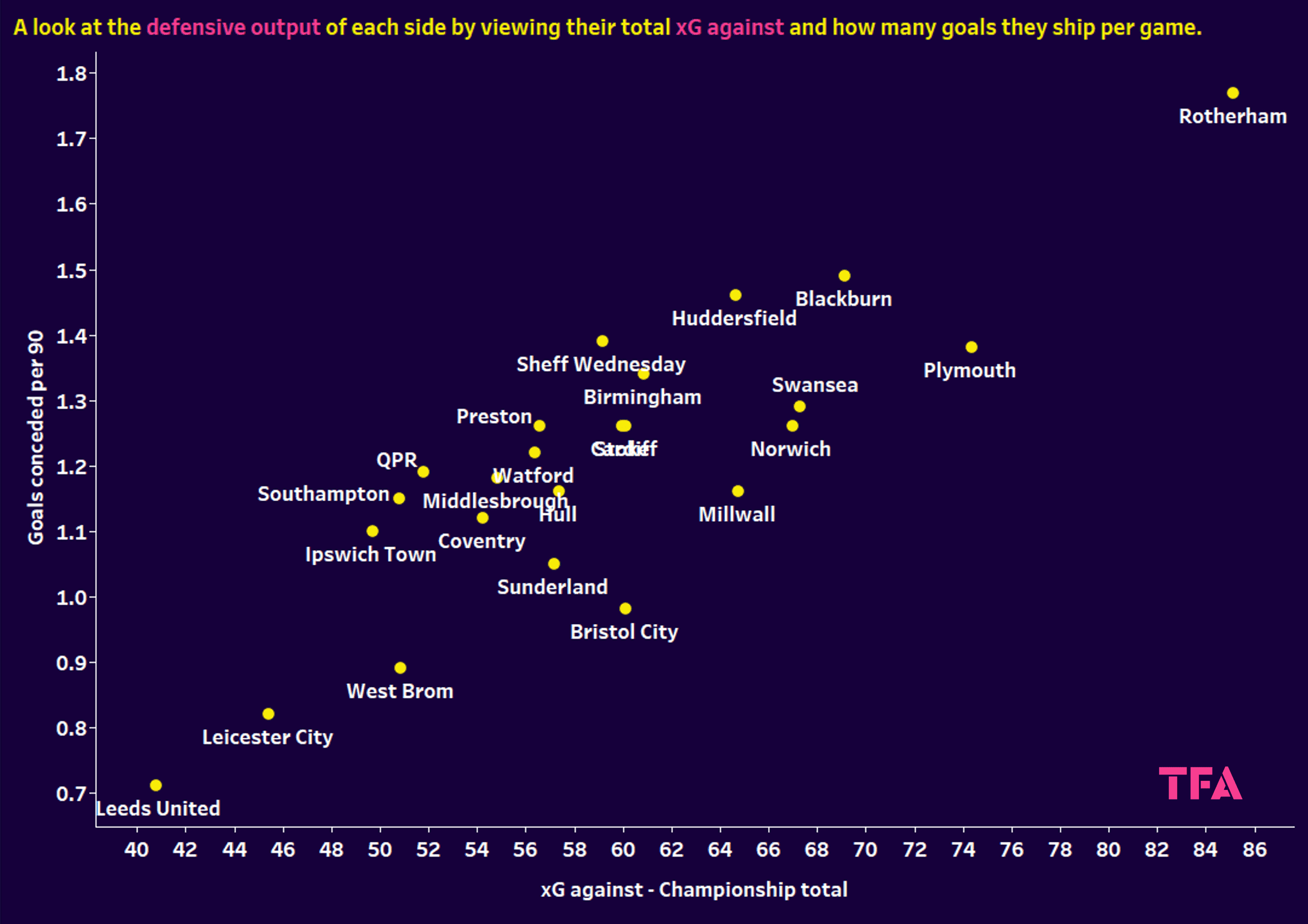
We have similar main points with each team’s defensive output. Already-relegated Rotherham United have, by some way, the worst defensive output in terms of xG against and goals conceded per game—the Millers being near the bottom end of statistical visuals is something you’ll get used to seeing in this article.
One team who has faced a high xG against them who are battling it out to secure a play-off spot is Norwich City. The Canaries have faced an xG of 66.98 while conceding 1.26 goals per 90 – this is something they’ll have to improve if they want to become an established Premier League side.
Build-up play: Possession-based vs direct approach
We move on to the first main segment of analysis as we dissect the difference in approach across the Championship. Here, we will look at the types of passes used, the tempo of play, and more as we look to get an idea of how each team prefers to build their attacks.
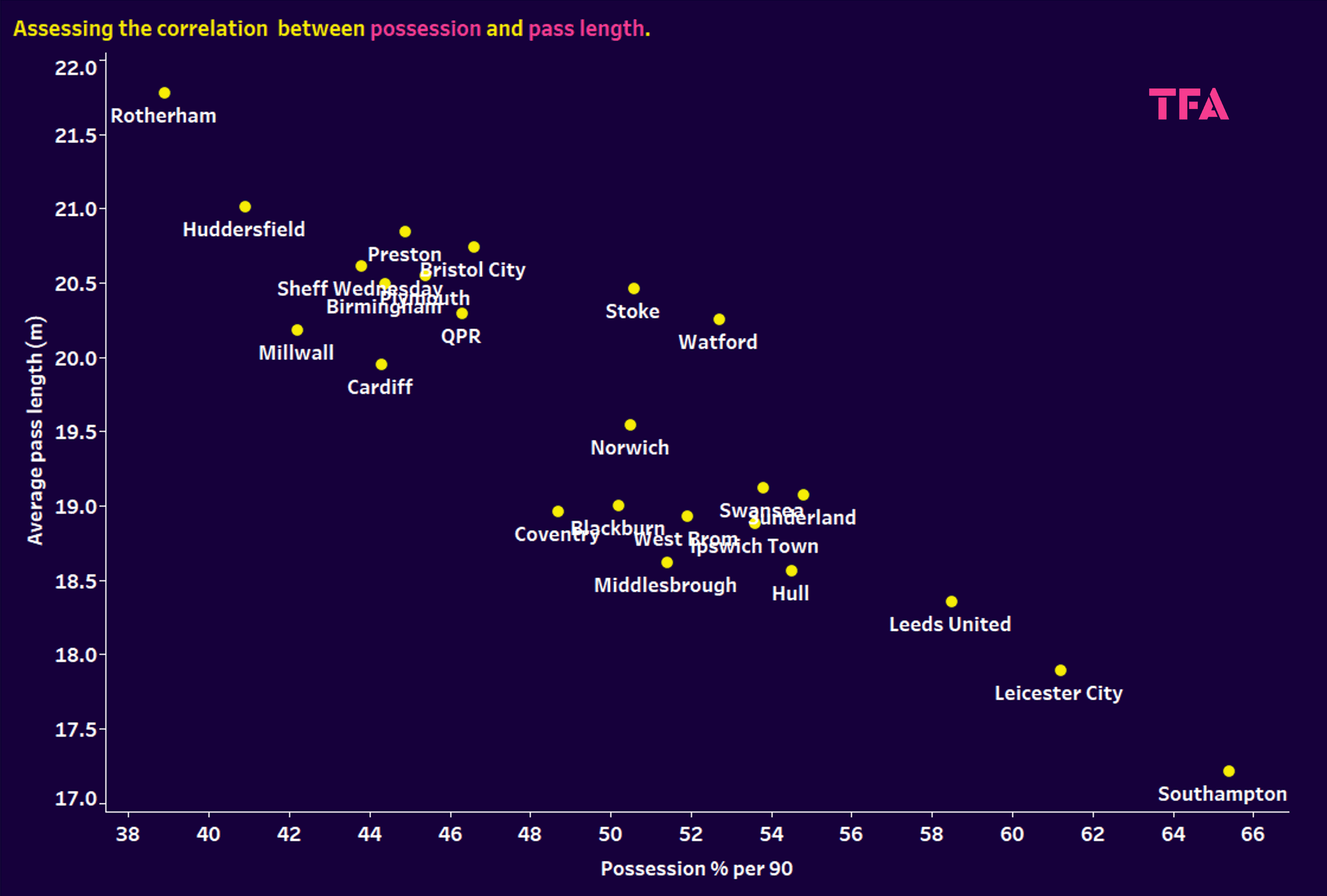
Starting with the bedrock of assessing a team’s build-up phase – rates of possession. We’ve paired this statistic with the average pass length metric to gain an idea of who plays longer passes in a low-possession-based etc.
As probably expected, Southampton has the highest possession percentage, controlling 65.4% of possession per game. This results in the lowest average pass length in the division. Generally speaking, throughout the league, more possession equals shorter passing.
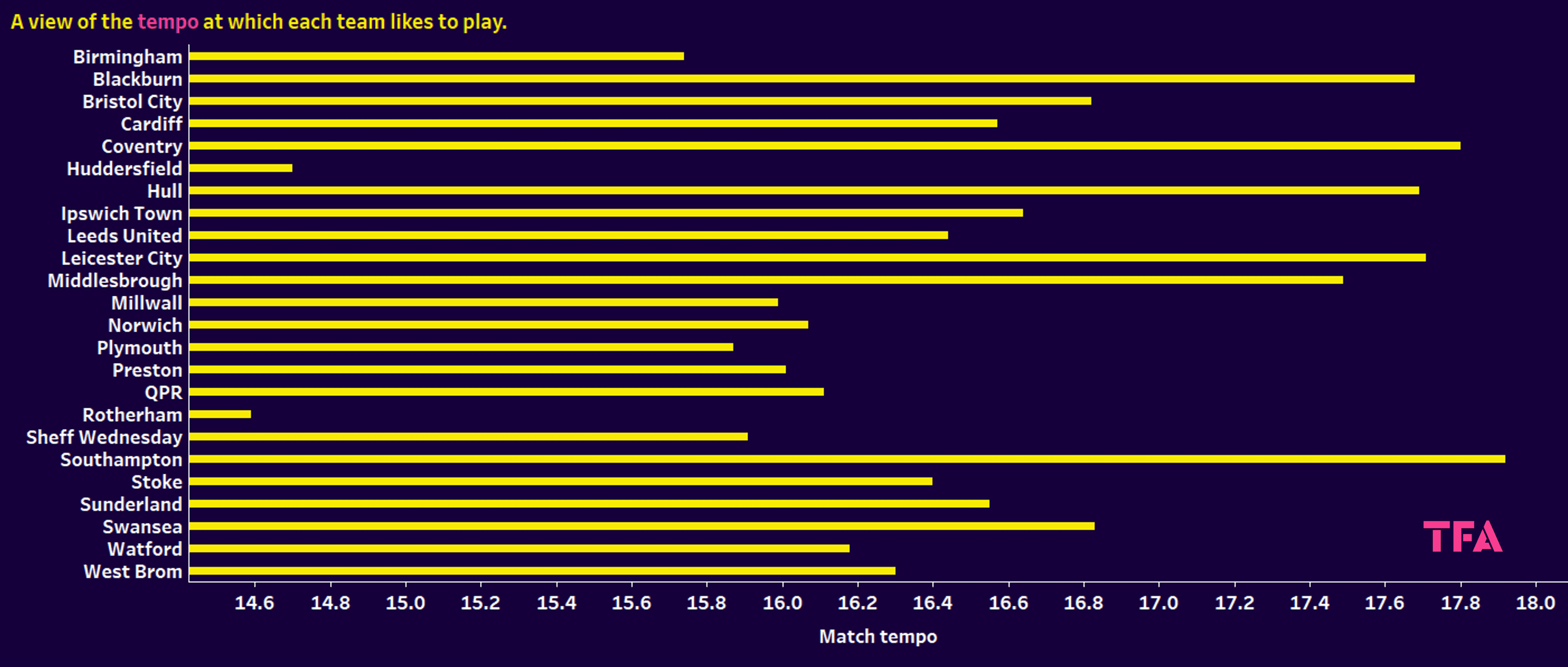
Match tempo refers to the number of passes per minute of pure possession. Essentially, a team with a higher match tempo moves the ball more via passes—it does what it says on the tin!
Some of your high-possession teams—Southampton, Leicester, Swansea, and Hull—all have a high match tempo, but one possession-based team that has a lower match tempo compared to the aforementioned sides is Leeds United, which shows signs of making fewer passes per minute.
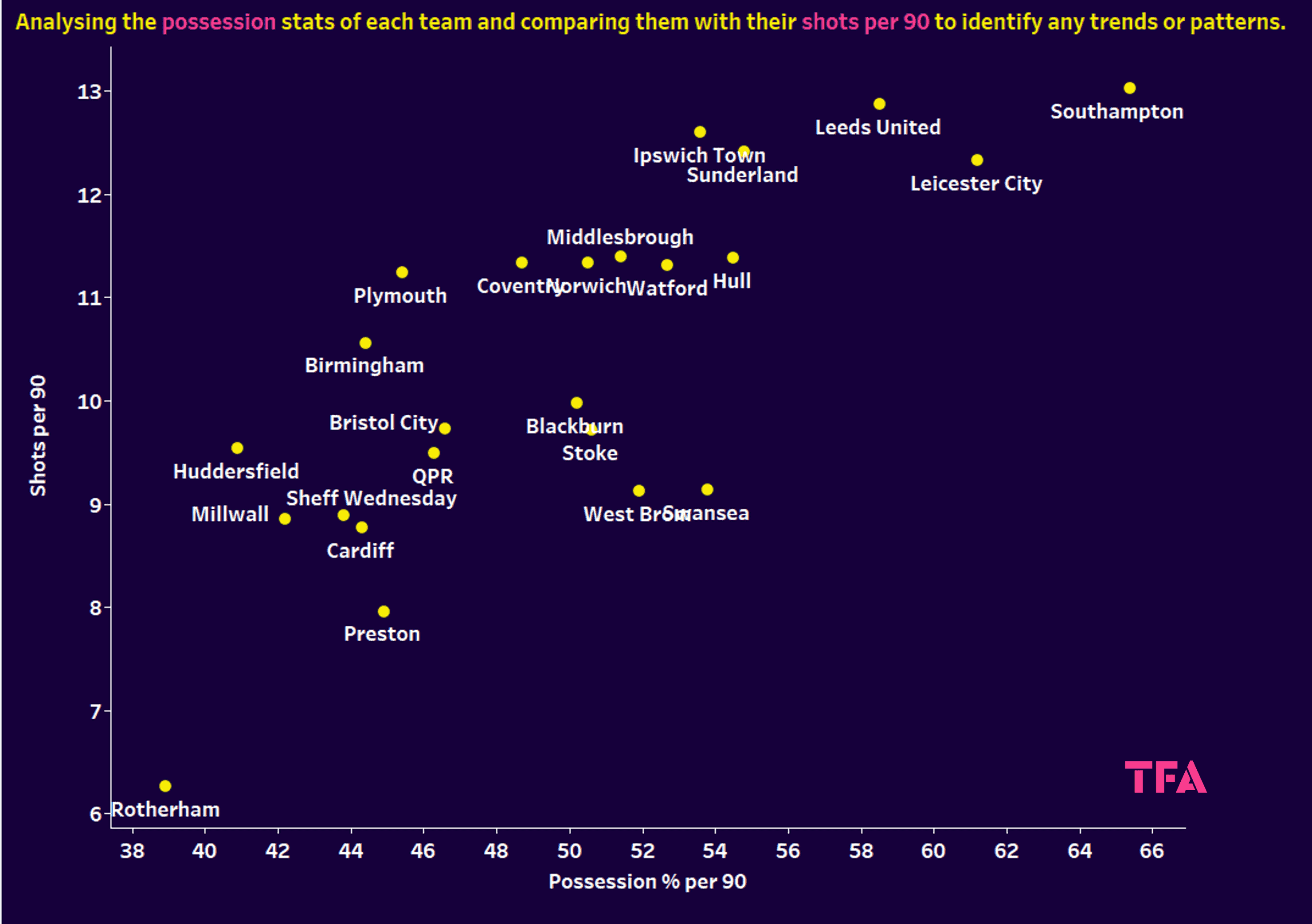
Next, we want to see if a higher rate of possession equals more shots on goal. Generally speaking, that does seem to be the case – Southampton, Leicester, and Leeds meeting that criteria. A few teams buck that trend, though – Birmingham, Plymouth, and Coventry, for example, average lower than 50% per 90 but make 10+ shots per 90. Swansea, though, average more than 50% possession per 90 but also average fewer than 10 shots per 90 – something for them to look at for sure.
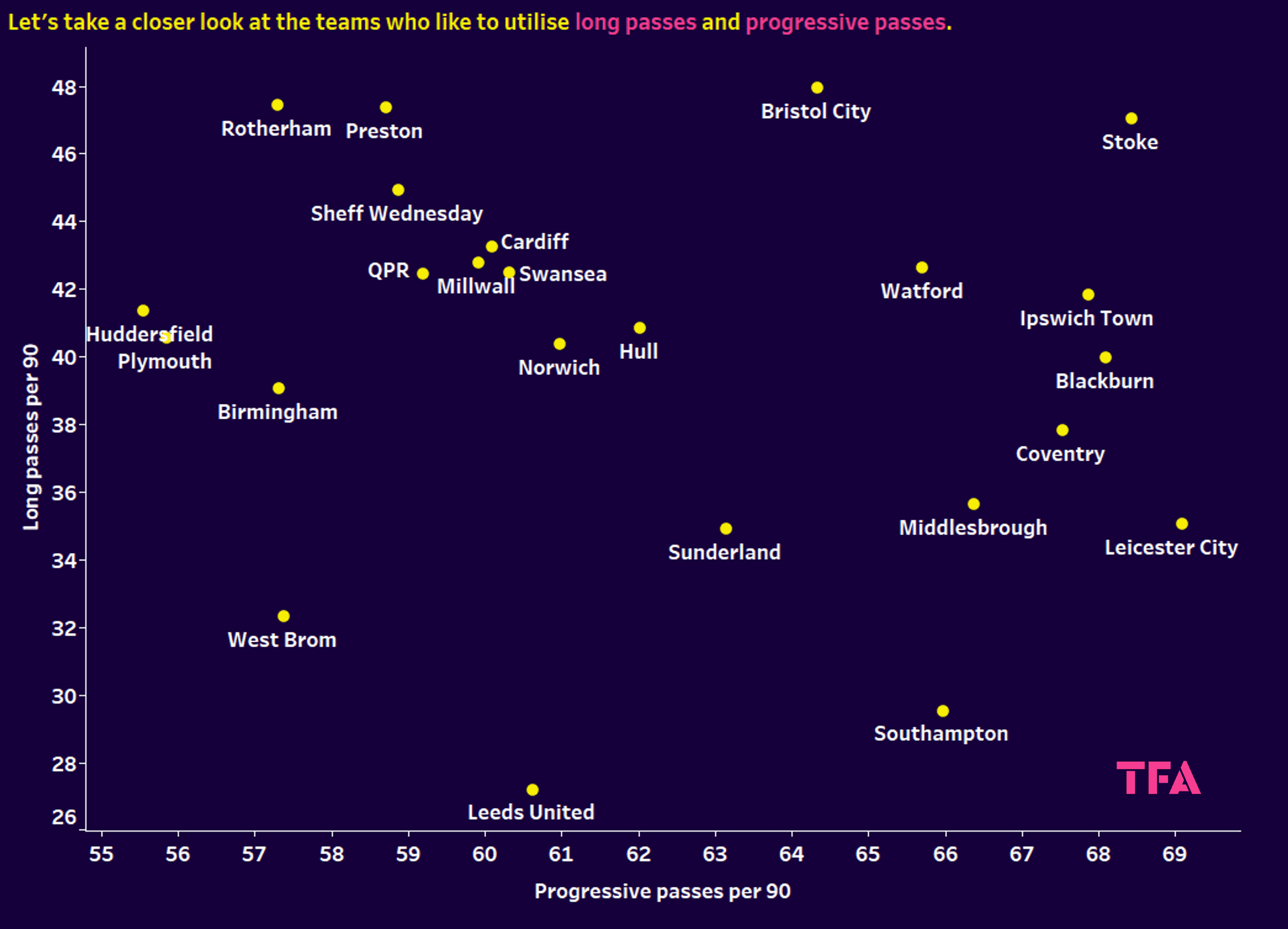
To take a look at the actions of the more direct teams in the Championship, we’ve compared the number of long passes and progressive passes per 90. There isn’t a general correlation like “teams who make more long passes also make more progressive passes”, but there are a couple of teams who like to utilise both frequently.
Stoke and Bristol City best fit that description, with the latter making more long passes per 90 minutes than any other Championship club. Their use of plenty of progressive passes suggests they are a highly direct team that likes to get the ball forward quickly. They also had one of the higher match tempos.
There are also teams that make a high number of progressive passes but a lower number of long balls—Leicester and Southampton crop up again, but Middlesbrough and Coventry also match the description.
Scoring and chance creation
Now that we’ve uncovered the build-up tactics of clubs in the Championship, we move on to how they approach proceedings in the final third. We have teams that like to rely on crosses utilised through balls and teams that take fewer shots but are clinical. Here, we explore various final third data to see how teams attack and who are the most effective teams in various attacking areas.
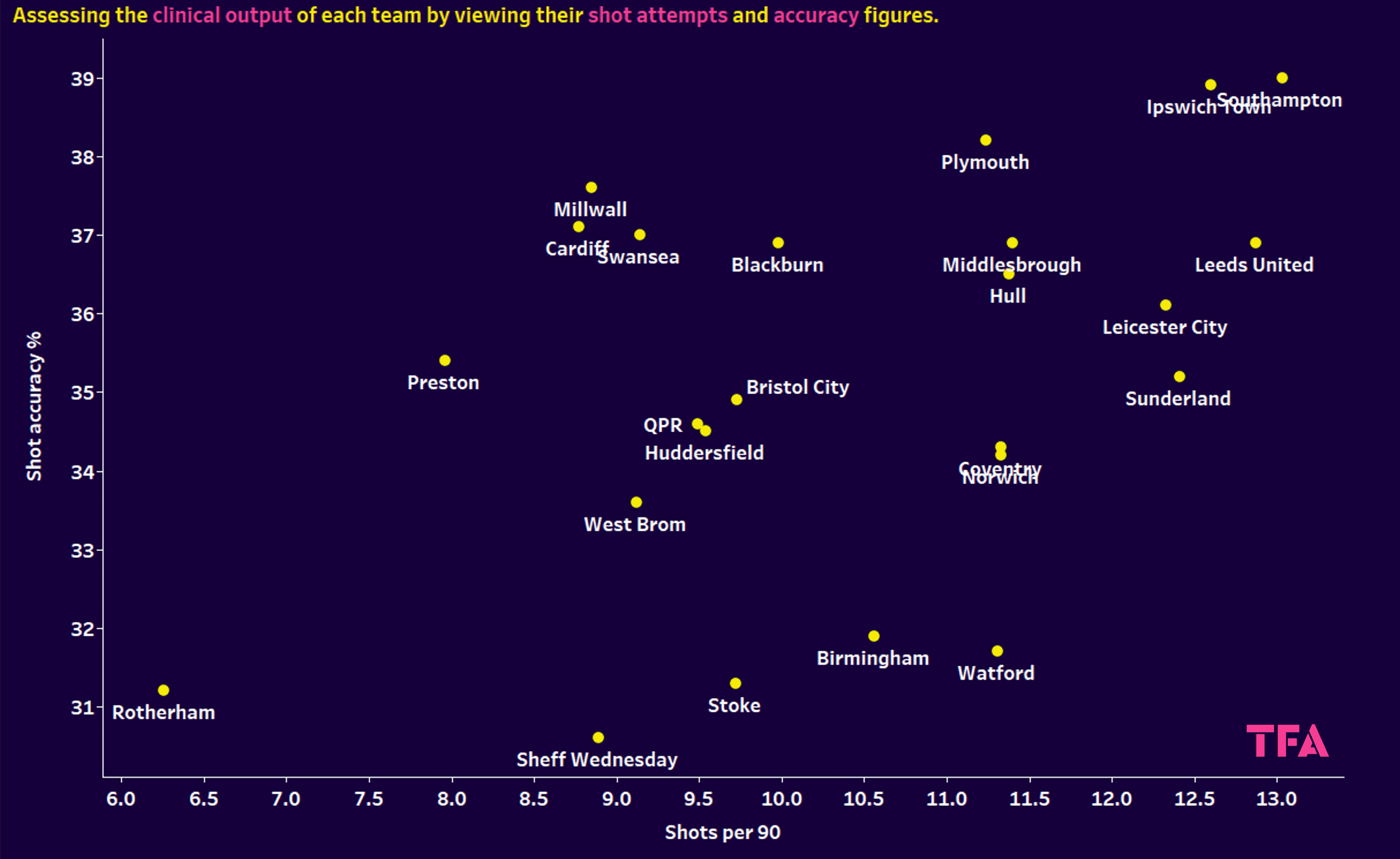
We took a brief look at the shot attempts average earlier, but by combining it with the shot accuracy metric, we get to see who is making better use of their efforts in front of goal. Yet again, the regular suspects appear on either end of the graph, but a few teams may surprise you slightly more.
Plymouth have both a high shot attempt average (11.24 per 90), despite being 18th in the league table, and also have a high shot accuracy, hitting the target 38.2% of the time. Argyle have managed a very respectable 58 goals so far this season but have shipped an eye-raising 69 – a huge part of why they find themselves in the relegation battle.
Middlesbrough and Hull are two sides that have outputs similar to Plymouth’s in terms of taking a strong number of shots with a decent accuracy rate. On the other end of the scale, there are sides like Millwall, Cardiff, and Swansea, which all average fewer than 10 shots per 90 but all have one of the higher accuracy rates.
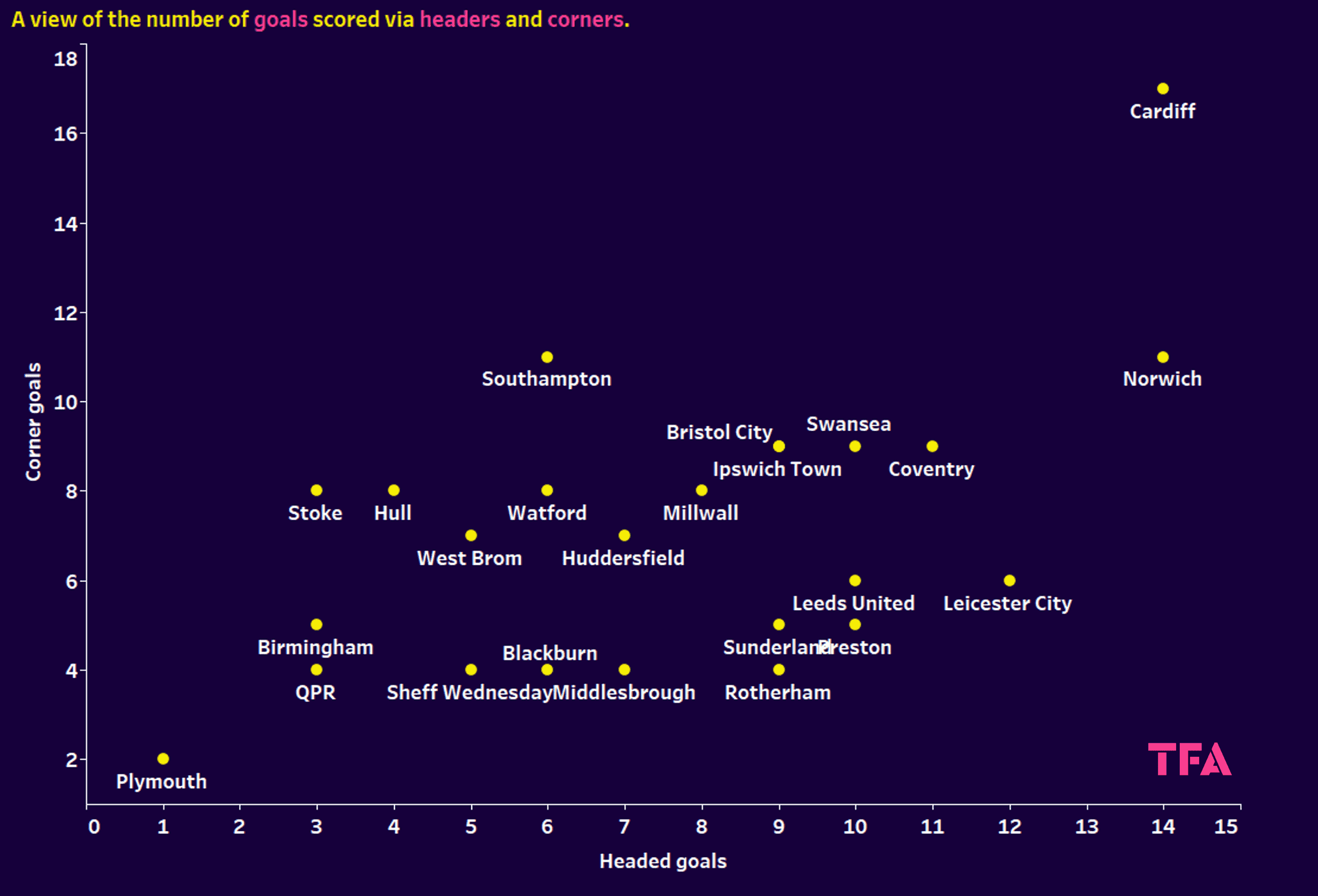
Aerial offence is an important method of attack for many teams, and it is a crucial part of Cardiff’s tactics, judging by the number of headed goals they have racked up (17) as well as scoring 14 headers. Utilising set plays and aerial attacks is clearly a part of the Bluebirds’ approach. Norwich are another team who follow similar tactics, with the Canaries scoring 14 headers while also bagging from 11 corners. Outside of those two, there aren’t any standout clubs who excel at both, but a cluster of clubs do well in one of these areas.
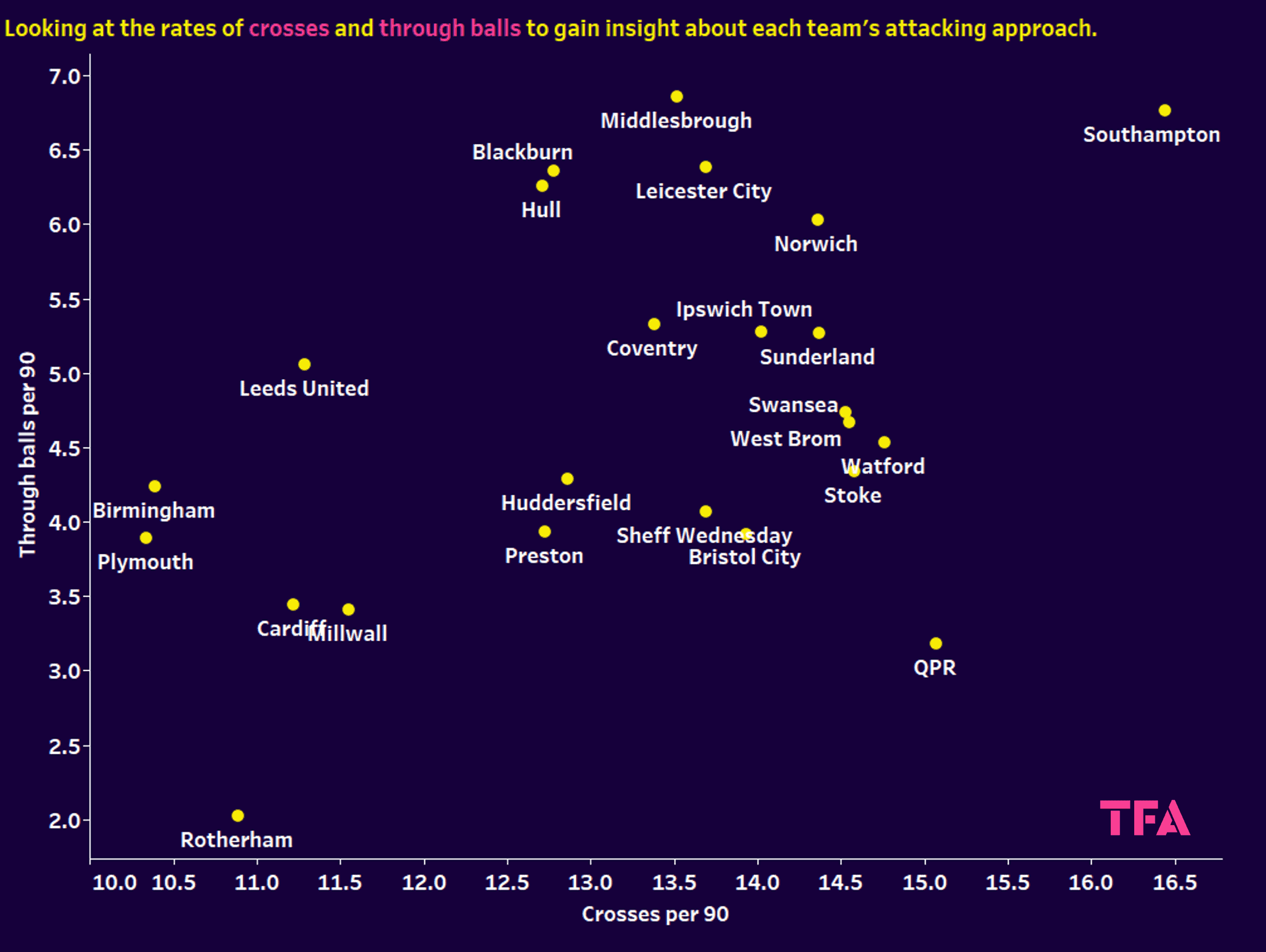
Once getting into the final third, crosses and through balls are two of the most effective ways of getting the ball into a dangerous shooting position in the box. Southampton, a team that dominates a lot of possession inside their final third, like to work the ball wide and put in plenty of crosses. On the flip side of that, Leeds, another possession-dominant team, have one of the lowest cross attempt rates in the division – a good insight into the variety of attacking approaches within the final third.
Norwich are perhaps the most varied team in terms of utilising a high number of crosses and through balls, which likely plays a part in their high shot attempt rate. Meanwhile, QPR seem to have a huge preference toward crossing instead of through balls.
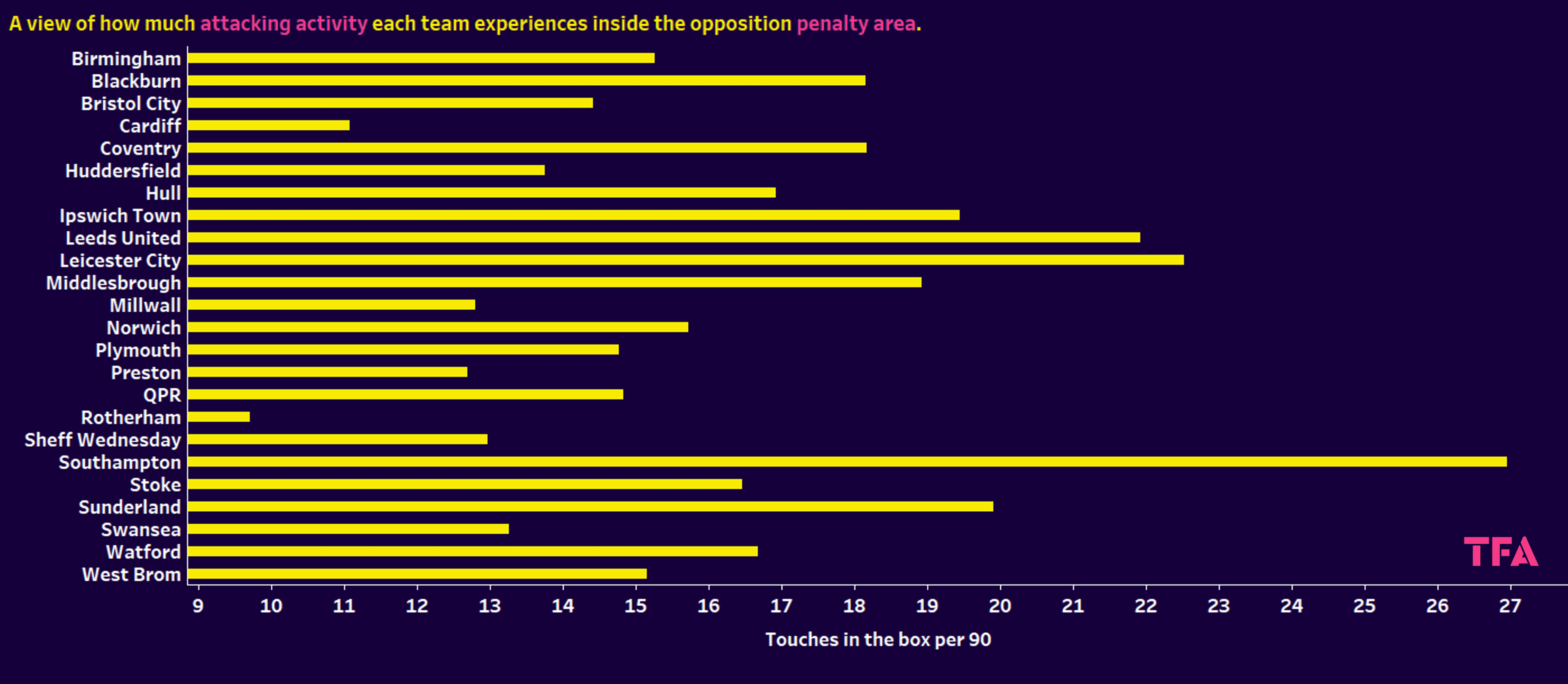
High-possession teams usually have the ability within the squad to dominate high areas, which means they are often successful at reaching the box, as we see in the graph above. Rotherham and Cardiff are two teams that struggle to have a high box presence in possession. The latter have shown that they are able to operate under those limitations, as we saw from their ability to put headed goals away.
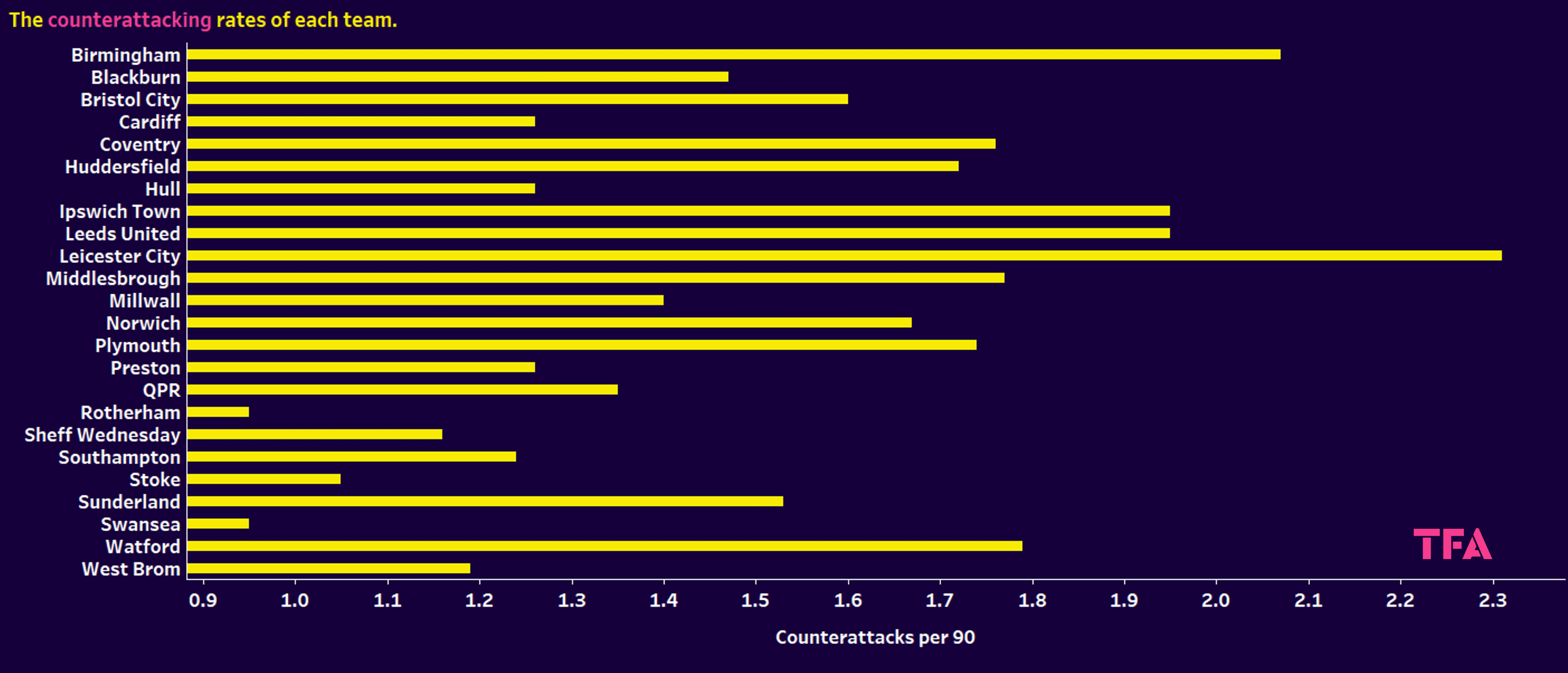
We’ve spoken a lot about the various areas that are dominated by possession-based teams, but the counterattack metric introduces some teams that don’t base their tactics on dominating possession. Some possession-based teams like Leicester and Leeds like to utilise counterattacks.
Other teams that enjoy a counterattack include Birmingham (2.07), Coventry (1.76), and Middlesbrough (1.77)—only Birmingham could really be considered a low-possession team. In contrast, the other two tend to have more even shares of the ball.
Out-of-possession
To wrap things up, we’ll examine how each team performs off the ball—who likes to be highly aggressive and engaging and who prefers to sit back deeper and soak up the pressure. These graphs will pair well with the in-possession statistics, which will be worth revisiting to answer any questions that may crop up about certain teams’ balance in tactics.
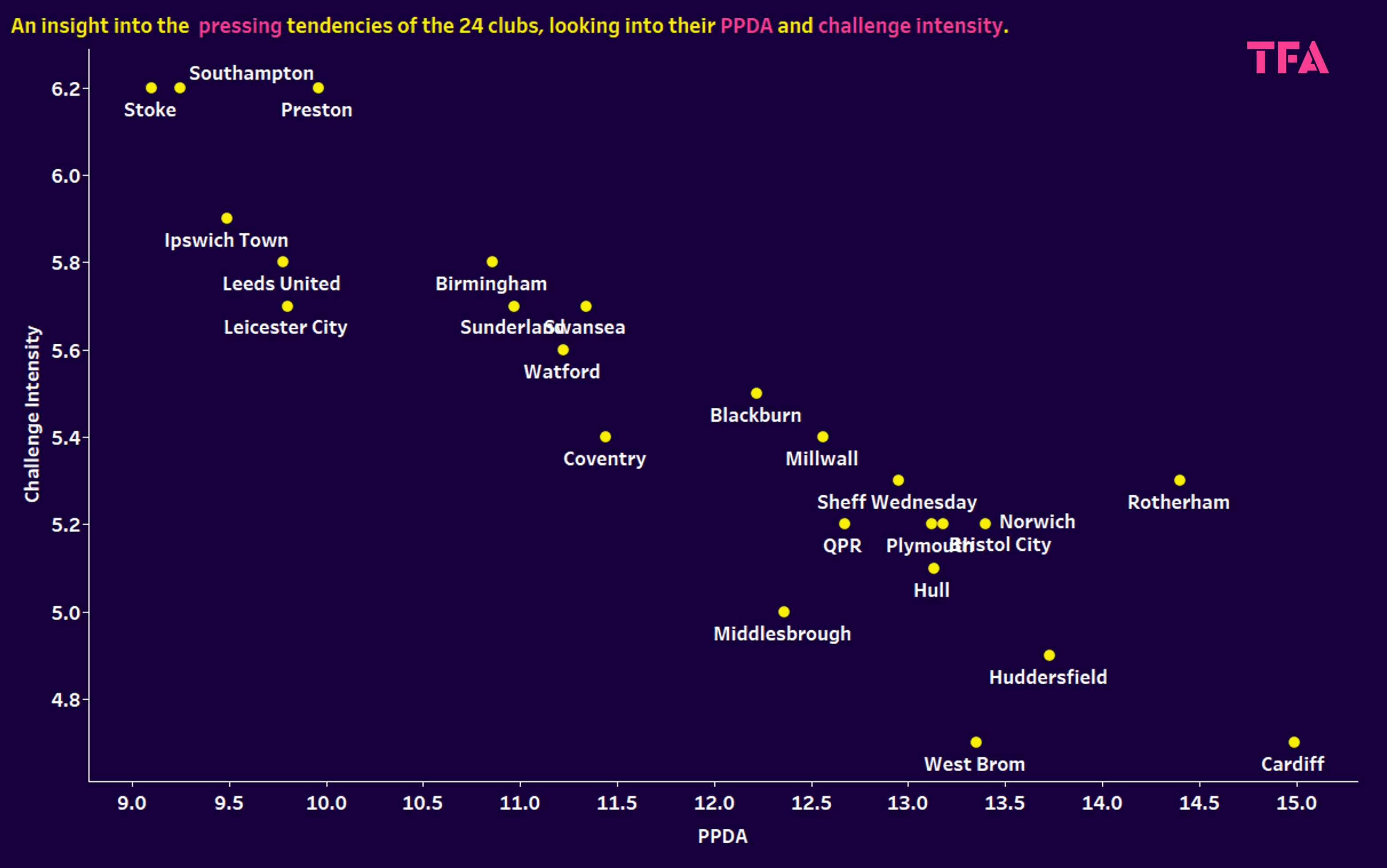
A high PPDA rating tells us that a team is more passive off the ball, as it allows more opposition passes per defensive action. We’ve combined this statistic with the challenge intensity metric, which charts how many defensive actions are made per minute of opposition possession—a high number here suggests a more aggressive approach.
Preston and Stoke are two of the most defensively aggressive sides in the Championship, with both sides having a high challenge intensity and low PPDA metrics. Other aggressive teams off-the-ball include Ipswich, Leeds, Leicester, and Birmingham, while Cardiff are the most reserved team defensively. West Brom are another team who prefer to soak up opposition pressure, as are Huddersfield Town.
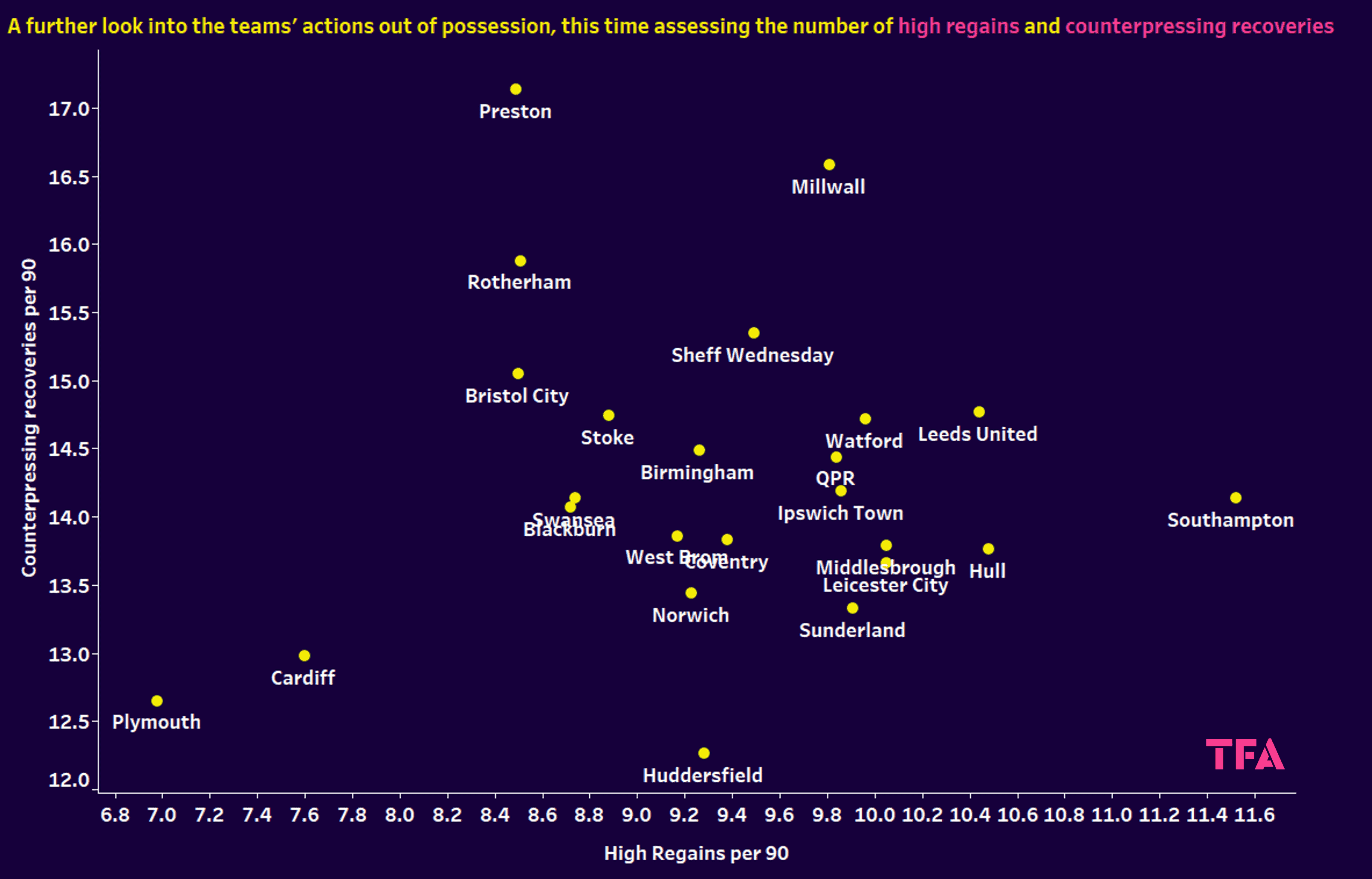
Building on the previous pressing statistics, we’ll look at how each team operates higher up the pitch in terms of winning the ball back, while we’ll also look at who likes to counterpress and who likes to regroup after losing the ball.
It is no shock to see Preston stand out again – as we said, they’re one of the most aggressive sides in the division. The Lilywhites average an incredible 17.14 counterpressing recoveries per 90, more than anyone else in the division – Millwall and, interestingly, relegated Rotherham also average a high number of counterpressing recoveries.
Southampton like to transfer their attacking aggression into their off-the-ball work, especially high up the pitch, making more high regains than anyone else (11.52) – Hull and Leeds sit the closest to the Saints.
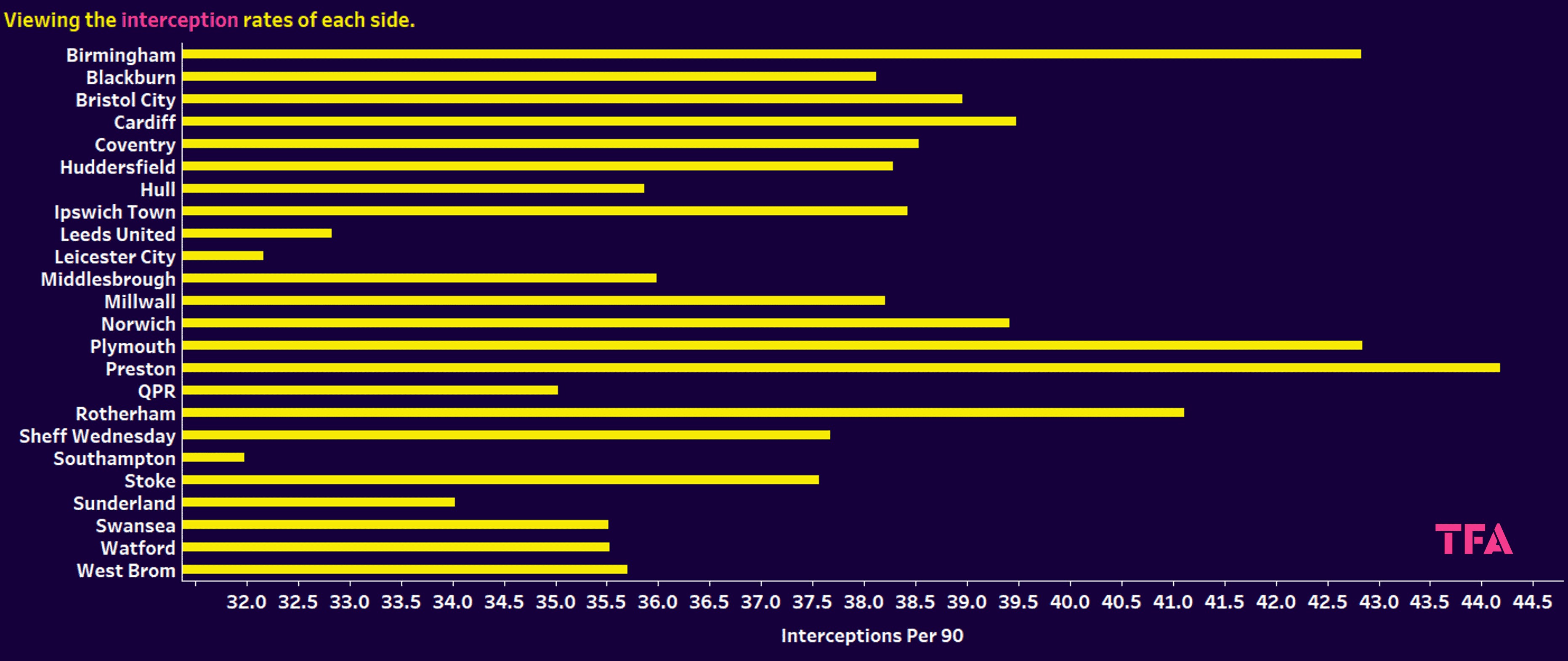
This final set of statistics shows us which team is the most consistent in breaking up opposition play. Preston are obvious contenders once again, further showing their hard work in defence. Birmingham and Norwich also rank high in this area, as do Rotherham. The Millers’ defensive actions are an interesting point, as mentioned. They are tasked with facing plenty of opposition possession, which means they are especially forced into defensive action in midfield places.
Conclusion
The aim of this data analysis was to give you, the reader, an idea of how each Championship club likes to play in various areas of the game. We’ve had unsurprising occurrences like Southampton dominating possession, but we’ve also had some more interesting and surprising data points like Preston being highly aggressive. The deep dive into the data also told us more about each team’s approach than simply looking at the surface statistics.






Comments